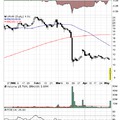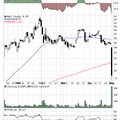aranylaz@freeblog.hu 2006. január 18., szerda
Címkék: aranyláz options position sizing mechanical trading algorithmic trading aranyláz 2006 január position management option strategy
2014.04.14. 02:21
Fórum link a pozició méretezésről, nagyon sok további hivatkozással.
One of Taleb's suggestions was to 'use historical data for developing a trading system, but never use historical data to set risk limits' as a 'Black Swan' even can occur at any time. Makes sense to me.
Worst case for a trader: combine a historically overfitted trading strategy with a historically overfitted risk management calculation
------------------------
Here it is, the most important chapter in this book, the most important chapter in my life, the most valuable thoughts I can transfer from me to you. I have nothing of more value that I could possibly give you than what you are about to learn. This is not an overstatement."
then ends it with:
"So there it is, my money management formula:
- (account balance * risk percent) /largest loss = contracts or shares to trade.
There are probably better and more sophisticated approaches, but for run-of-the-mill traders like us, not blessed with a deep understanding of math, this is the best I know of. The beauty of it is that you can tailor it to your risk/reward personality. If you are Tommy Timid, use 5 percent of your bank; should you think you are Normal Norma, use 10 percent to 12 percent; if you are Leveraged Larry, use from 15 percent to 18 percent; and if you are Swashbuckling Sam or Dangerous Danielle, use in excess of 20 per cent of your account ... and go to church regularly.
-------------------------
- Bet Sizing Article by Ed Seykota and David Druz
- Gibbons Burke Article on Money Management (PDF)
- Seykota Risk Management Resource
- Kelly Formula and Data Transmission
- White Paper by Johan Ginyard (PDF)
- Johan Ginyard Position Sizing Interview
- Frequency v. Magnitude White Paper
- Web Resource for Math, Black Jack, Kelly, etc.
- Edward O. Thorp: Beat the Dealer (PDF)
- Kelly’s Original paper, March 21, 1956 (PDF)
- The Sharpe Ratio
- Tutorial Risk-adjusted Return
--------------------------
"... cut your losses and move on. the first rule of money management should be to limit your losses. By selling out now, you will have hopefully experienced only minimal losses and maintained proper trade discipline.
At what point should you exit? There are many schools of thought, but I am most comfortable with establishing position risk and loss limits using a modified kelly system. Basically, the kelly method is adapted from gambling theory and is a way to quantify your "bet size" (in this case position loss risk) based on your capital and expectancy, the goal is to optimize your position size while limiting your risk of ruin.
The kelly formula is %winners *(average$per win/average$ per loss-1)/(avg$per win/avg$ per loss) so that for example if you win on 40% of trades and have an average win/loss ratio of 1.5 to 1, the kelly =.4*(1.5-1)/1.5 = .133. i use a "20% kelly" which means in this example that i would risk no more than 20% of 13% of my capital or 2.66% of my capital.
I use the kelly along with option greeks to set stop loss and position size thresholds before entering a trade. Thus, following the above example, assume i have initial capital of $20000. My 20% kelly says that I should risk no more than 2.66% of that or roughly $530. I look at an option that I want to buy. as a buyer I know my main greek risks are theta (time decay) and vega (volatility decline). For the particular option I am interested in lets assume that the theta is $2 and the vega is $25. since vega looks like the bigger risk I ask "what if IV drops 20% from its current level of 16%?" that would mean IV would be then 12.8% (.16 *(1-.2) = .128). that would put me at a vega risk of about $80 per contract: (16-12.8)*$25=3.2*$25=$80. with my kelly telling me to risk no more than $530, I know I should have no more than 6 contracts (530/80 =6.6 or 6 rounded down). then I look at theta. at $2 per day and six contracts, i can calculate how long to stay in the position: $530/($2*6)=44 days. so now i have my exit parameters. if IV drops below 12.8% i'm out. if the position shows no gain, i am out in 44 days. obviously if price movement reduces the value of the position by $530 at anytime, i'm out.
So, basically I'm suggesting that the best way to limit losses is not by trying to find a killer adjustment strategy to a losing position. Rather, the idea is to have an exit plan in place with set thresholds and reasons for closing. obviously some adjustments can be made but often the most prudent thing to do is just get out."
A bejegyzés trackback címe:
Kommentek:
A hozzászólások a vonatkozó jogszabályok értelmében felhasználói tartalomnak minősülnek, értük a szolgáltatás technikai üzemeltetője semmilyen felelősséget nem vállal, azokat nem ellenőrzi. Kifogás esetén forduljon a blog szerkesztőjéhez. Részletek a Felhasználási feltételekben és az adatvédelmi tájékoztatóban.

